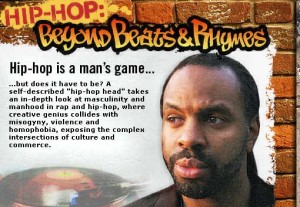
For stats wonks like so many of us here at TSP, even the tiniest trend can be exciting when it’s spotted somewhere in the HabiTrail of Google Analytics. And guess what we found? You social science-lovers—particularly those of you who are most likely to be gearing up to mold some young minds next week—are searching, every week, for good lists of movies to show in your classes. For the past four years, a consistent way you’re finding yourselves at The Society Pages is an old, short post pointing you to a concise but fantastically useful list CUNY sociologist Jessie Daniels put together for just such a syllabus-writing moment. So now, to really make your weekend-before-spring-semester, we’ve gotten a hold of Jessie to talk with her about how she uses films in her courses, the online repository she’s created so that others can suggest their favorite social science documentaries, and her top new picks for today. Enjoy!

The Society Pages: A 2008 post titled “Great Films for Sociology Classes” remains one our most-read. While we don’t have date-specific data, we imagine Google searches for “sociology documentary” tend to spike a bit around the ends and beginnings of semesters. Can you tell us a bit about how it is you find most professors are actually using films in their classes?
Jessie Daniels: I think there is a perception that showing a film in class is a “day off” from teaching, but that’s certainly not true in my classes, nor is it true for most of the other professors I know. Sometimes students, too, have that notion—it’s probably a hold-over from some bad teaching practices (like hitting play and leaving the room!), but in my classes, films are as important as written texts. I even refer to them as “visual texts” in my syllabi and encourage students to take them seriously from the start.
In terms of assignments, I put a lot of work into finding documentaries that relate to written texts, whether books or peer-reviewed articles. Then I create “video worksheets” to help students make connections between the assigned readings and the films. This is, I think, really useful for students today, who’ve grown up in a visual culture and expect to learn through images, but don’t have the critical media literacy they need to de-code these images.
The combination of films and more difficult readings is also a great tool for my classes here at CUNY, where students come into their classes with a very wide range of skills and hugely diverse cultural backgrounds. Screening films in class provides a shared experience, language, and context that can provide entry into the written texts.
TSP: Since the original post appeared here on our site, you’ve expanded your list of recommended documentaries into a wiki so that others can add their favorites to your curated list. Are there any newer documentaries that haven’t yet made the list, but should?
JD: Yes, there are a bunch that I need to add. A couple that deal with globalization and neoliberalism that I used this last semester, “The End of Poverty?” and “Garbage Dreams,” come to mind. I like these films for different reasons, and I like teaching them “against” each other because they offer contrasting representations of people living in poverty. In “The End of Poverty?” the “poor” are a collective without back stories, while in “Garbage Dreams,” we get to know individuals as three-dimensional human beings.
TSP: What about a couple of Top Five lists for specific courses?

JD: For an Intro to Soc class, some of my Top Five include:
- “49 Up” (2005) Directed by Michael Apted.
- “The Split Horn: Life of a Hmong Shaman in America” (2001) Directed by Taggart Siegel.
- “Quiet Rage” (about Zimbardo experiments).
- “The Devil’s Playground” (2002) Directed by Lucy Walker.
- “We Live in Public” (2009) Directed by Ondi Timoner.
 And for an undergrad Gender Course, I’d recommend:
And for an undergrad Gender Course, I’d recommend:
- “HIP-HOP:Beyond Beats & Rhymes” (2006) Directed by Byron Hurt.
- “Southern Comfort” (2001) Directed by Kate Davis.
- “The Pill” (1999) Directed by Erna Buffie and Elise Swerhone.
- “Chisolm ‘72: Unbought & Unbossed” (2004) Directed by Shola Lynch.
- “Heart of the Game” (2005) Directed by Ward Serrill.
TSP: Fantastic! And do you want to name names on any documentaries that should have been great—the topic was great, the timing was good—but were ultimately disappointing? Could any be redeemed by pairing them with other materials that’d help them work in class after all?
JD: Well, I guess this is a good place to mention “Waiting for Superman.” It got a lot of media attention (including an entire Oprah episode!), in part because it had huge funding from backers like Bill Gates (who spent $2 million on the distribution of that film.) Anyway, It should have been a good film—the filmmaker David Guggenheim had won a Best Documentary Academy Award for “An Inconvenient Truth”—but it wasn’t. Basically, it ended up being a feature-length infomercial promoting charter schools and bashing teachers’ unions.
Instead, I recommend Madeleine Sackler’s 2010 film “The Lottery.” It’s also about inequality and the failures of our school system, but it didn’t get much press. It’s a terrific film, and I highly recommend people use this one instead.
Another education film that deserves attention is 2007’s “Resolved” (directed by Greg Whiteley). It looks at the intense world of high school debate and follows several debaters, including two young African American teens who take on this predominantly white world. I’ve always thought this would be an excellent documentary to use with either (or both!) Patricia Hill Collins’s Black Feminist Thought or Joe Feagin’s White Racial Frame. You see all these ideas about race, whiteness, knowledge, and framing played out in the world of high school debate, and it’s a terrific, inspiring story.
TSP: Finally, we’d like to know a little bit about your forthcoming research on the subject of using film as a teaching tool. Can you give us some updates?
JD: I’ve always been interested in “visual sociology” and how people make meaning with and learn through imagery. Early on in my teaching career, I used a short clip from a news magazine show that used a hidden camera to catch people in the act of racial discrimination (“True Colors,” ABC PrimeTime Live). It was the most effective teaching tool I’d ever seen—much more so than assigning a peer-reviewed article that said the same thing or having people come present on a panel. With that one short film clip, I felt my students understood more deeply how racial discrimination operates on a daily basis, and we could jump right into a different discussion level in the classroom.
Over time, documentary films became more widely and readily available, so I began to incorporate them into my classes. I had the sense they’d be effective, too, but I wanted to test it a bit and followed up with students after they took an Intro Soc class. Most of them said things like, “It helped me grasp more of the material,” which was what I predicted. I’d like to do more with this—say, by comparing sections of the same class, one which uses films while the other doesn’t—to get a better idea, but that will have to wait, since I’m not teaching Intro now (someone else should do it, though!).
I’m also writing a piece describing the method I use to pair films with readings, video worksheets, and the development of critical media literacy. This article also relates the story of how one of my classes used what they’d learned to organize their own community event. They used a documentary film to raise awareness about police brutality in the wake of the killing of Sean Bell, a young African American man, here in New York City. Part of what made their event so cool was that they included a YouTube clip to start, then did interpretive readings of some of the comments that had been left on YouTube.
To learn more about Jessie Daniels and her teaching philosophy, research, and life of curiosity, please visit her personal website or follow her on Twitter @jessienyc. You can also check out her social science documentary wiki—and add your own favorite choices—here. And if that’s not enough, we’ve even got an Office Hours episode featuring Dr. Daniels at the ready!

Comments 16
Letta Page — January 15, 2012
Josh Page, a professor of sociology (particularly law, crime, and deviance) at the University of Minnesota, sends in his Top Five list for teaching undergrad courses on the criminal justice system, noting "The 'reality' TV stuff about prison life is pretty much uniformly bad."
Top Five Prison Documentaries for Crime and Punishment Courses
1. Sweethearts of the Prison Rodeo (2009) http://sweetheartsoftheprisonrodeo.com/
2. The Dhamma Brothers (2008) http://www.dhammabrothers.com/
3. The Farm (1998) http://www.imdb.com/title/tt0139193/
4. Writ Writer (2008) http://www.writwritermovie.com/
5. Ghosts of Attica (2001) http://icarusfilms.com/new2001/gho.html
Favorite Re-entry Documentary
Omar and Pete (prison reentry) (2005) http://www.pbs.org/pov/omarandpete/
Please do share your own "Top Fives" in the comments - we'd be happy to help Dr. Daniels update her list.
Letta Page — January 16, 2012
Another great friend of The Society Pages, Prof. Andrew Lindner of Concordia College, Moorhead, writes in with his own favorite documentaries with teaching. He said he'd have included "49 Up," but since it had already been mentioned, these are his next Top Five, culled from the film series he puts on every semester at Concordia:
But I do a film series every semester on campus, so here are a few not mentioned:
1. "Manufactured Landscapes" (2006), based on the work of photographer Edward Burtynsky, it has some unbelievable footage from Chinese factories. Great for teaching about globalization and capitalism.
2. "Paradise Lost: The Child Murders at Robin Hood Hills" (1996) - a classic documentary on the (now recently freed) West Memphis Three. A powerful and disturbing illustration of stigma and social control.
3. "The War Room" (1993) - an insider's look into Bill Clinton's path to victory in the 1992 primaries. I use this in my "Political Sociology" course to talk about rhetoric, political strategy, and political professionals.
4. "Flow: For Love of Water" (2008) - a terrifying documentary on our dwindling water supply and how it is owned and managed by corporations for profit. Great for discussions of capitalism, privatization, or environmental sociology.
5. "Secret of the Wild Child" (1994) - an outstanding PBS/Nova documentary on feral children, particularly the famous Genie case mentioned in almost every sociology text. Challenges many students assumptions about socialization.
Letta Page — January 16, 2012
The third additional set of films to hit our inboxes comes from the incomparable Monte Bute, of Metro State, who is well-known for his approach to teaching about death and dying while, well, experiencing these ultimately social phenomena. Monte pointed out that he generally has not found documentary to be a particularly good way to help students enter into the world of death and dying, but was readily able to supply five fictional films that work beautifully in a classroom---even one approaching a sometimes too-close topic.
1. "Ikiru," directed by Akira Kurosawa
2. "The Seventh Seal," directed Ingmar Bergman
3. "Of Gods and Men," directed by Xavier Beauvoix
4. "Tell Me a Riddle," directed by Lee Grant
5. "Dead Man," Jim Jarmusch
To hear more about Monte's approach in the classroom, listen to his episode of the Office Hours podcast here on The Society Pages or check out his own TSP blog, A Backstage Sociologist.
Nathan Palmer — January 22, 2012
This is such a great idea and I’d like to thank TSP and Jessie Daniels for doing this. Resources like this and The Sociological Cinema make finding great videos for our classes so much easier. Thanks for taking the lead on this and for allowing the rest of us to share.
My Top Five Documentaries.
Race The Power of an Illusion Pvert 3: The House We Live In (2003)
My favorite film to show how historic and institutional racial discrimination is affecting us to this day. It does a great job connecting whiteness to citizenship and explaining red lining/block busting. I use it in my 101s and race & ethnicity classes.
The Color of Fear (1994)
An oldie, but a goodie. The film is a recording of 9 men of different racial ethnic backgrounds talking candidly about race. My only critique of the film is there are no women included and multiple racial groups are left out as well.
Food Inc. (2008)
More than anything I want my students in my environmental sociology class to understand how social inequality and environmental degradation are connected. The portion of this film dedicated to the mistreatment of farmers, factory workers, and the animals/land they use is priceless.
The Battle for Whiteclay (2008)
This independent film documents how 4 liquor stores in Whiteclay, NE (a town of 14 people) sell 12,500 cans of beer a day. The off-sale liquor stores take advantage of their proximity to the Pine Ridge Reservation, who banned alcohol sales and possession on their lands. Despite there being no legal place for the 12,500 cans to be consumed (Whiteclay only has off-sale establishments) there have been nearly no arrests while the liquor dealers make millions of dollars annually. The video is an excellent example of government corruption, exploitation, and selective law enforcement.
Inside Job (2010)
The 2008 credit crisis is a perfect example of how changes at the institutional level have a cascading affect all the way down to the individual. It also gets at how social problems are socially constructed. This film more than any other explains the complex crisis in a way that is approachable.
Thanks again for doing this,
Nathan, SociologySource.com & SociologyInFocus.com
Sarah Esther Lageson — January 24, 2012
One site I have relied on for seeking out sociologically relevant videos is Sociology at the Movies.
I also think a neat project for students in food or labor-related courses is to view Edward R. Murrow's Harvest of Shame, then view a selection of contemporary documentaries that highlight how little has changed since 1961. Some really great documentaries include:
American Harvest,
The Harvest/La Cosecha,
and New Harvest, Old Shame.
Carolyn Liebler — January 24, 2012
For example, I show a short clip from:
1) Little Miss Sunshine - for students to pick out examples of material culture, non-material culture, subculture, counterculture, face and face work, front stage, and back stage behavior.
2) Wedding Crashers - as a way to apply the following theories of deviance: rational choice, labeling theory, differential association theory, and obligatory action.
3) The beginning of Ghostbusters - to apply the three major tenets of ethical research methods
4) Fiddler on the Roof - to play "spot that social institution!" and talk about how social institutions are interrelated.
Letta Page — January 27, 2012
Dedicated friend-to-TSP Joe Soss (the subject of the second "Special Feature" which just went online earlier today) sends in this list of his Top 5 for the classroom:
1. At the River I Stand
2. Merchants of Cool
3. Occupation: Dreamland
4. Stonewall Uprising
5. Inside Job
Chip Warren — February 26, 2012
Greetings,
As a documentary filmmaker, I'm always interested in how our work is being used in the classroom. Invariably, after one of our programs airs, we get lots of calls from teachers interested in using the material in the classroom, both high school and college.
I'm working to take things a step further, to learn how the material is being used, and how we can create better tools for teaching the issues surrounding our docs (kids in the juvenile system). So if you read this, and have an interest in the juvenile justice or child welfare systems, please get in touch. I'm happy to share our work in exchange for a dialogue about how you use it. I'd love to be able to provide pedagogical tools to accompany our docs and it seem like the best way to do that is talk to the folks who are using docs in the classroom.
Best,
Chip
Calamari Productions
Thom Friend — March 14, 2013
College student here, taking courses on media & gender. Some of my favorite documentaries we have viewed in the classroom:
- Generation M: Misogyny in Media & Culture
- The Mickey Mouse Monopoly
- Iron Jawed Angels (Dramatization of the Women's Suffrage Movement)
- Tough Guise: Men and Masculinity in Media
- Further Off the Straight & Narrow
- Makers (PBS)
Then some of my personal recommendations:
- Zeitgeist: Moving Forward
- Power and Terror: Noam Chomsky
- Forks Over Knives
Letta Page — May 9, 2013
Just saw "Pull of Gravity" (http://www.pullofgravityfilm.com/) and of course there's "The Road From Crime" (http://thesocietypages.org/teaching/2012/11/27/the-road-from-crime-film/), both documentaries on prisoner reentry. I recommend them both.
Sociology + — December 23, 2013
Looking for high school sociology lessons and age appropriate films.
Stephanie Gilbert — December 29, 2013
Freedom Riders is an excellent visual of social movements & social change
Friday Roundup: May 10, 2013 » The Editors' Desk — April 1, 2014
[…] media studies, and every other class you might be teaching or taking. To learn more, visit this interview with Jessie Daniels and its extensive comments with suggestions from other profs and stude… (many with links) or this older post with some more good […]